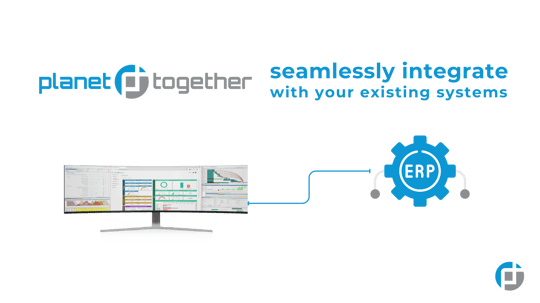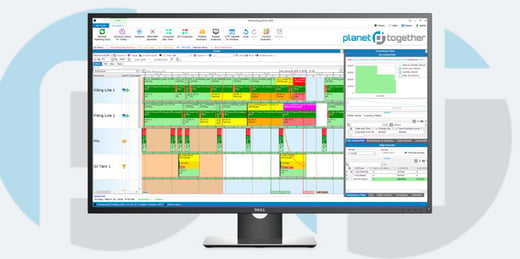
Balancing Local and Global Sourcing Schedules: APS Strategies for Supply Chain Managers in Pharmaceutical Manufacturing
In pharmaceutical manufacturing, supply chain managers face a critical balancing act: how to align local and global sourcing schedules to ensure reliable production, control costs, and meet regulatory demands. The stakes are high — a delayed shipment of an active pharmaceutical ingredient (API) or excipient can ripple across production lines, disrupting the delivery of life-saving therapies.
Advanced Planning and Scheduling (APS) systems like PlanetTogether, when integrated with major enterprise systems such as SAP, Oracle, Microsoft Dynamics, Kinaxis, or Aveva, offer powerful capabilities to streamline and balance these complex sourcing strategies.
This blog explores how pharmaceutical supply chain managers can use APS to harmonize local and global sourcing, improving agility, resilience, and profitability.
The Local vs. Global Sourcing Dilemma
Supply chains in the pharmaceutical industry operate under unique pressures:
Local sourcing offers shorter lead times, easier oversight, and reduced logistics complexity.
Global sourcing can provide cost advantages, access to specialized materials, and scalability, but introduces risks like long lead times, geopolitical disruptions, tariffs, and regulatory variations.
Balancing the two is not just a matter of cost — it is a matter of risk management, speed to market, and quality control. For example, sourcing APIs from overseas may lower raw material costs, but if geopolitical tensions disrupt shipping lanes, local suppliers suddenly become vital to maintain production.
Without a system capable of integrating these variables, supply chain managers are left making decisions on spreadsheets or disconnected platforms, risking missed opportunities and reactive firefighting.

The Role of APS in Sourcing Balance
An Advanced Planning and Scheduling system like PlanetTogether acts as the “brain” that unifies multiple streams of supply chain data into a coherent, optimized plan.
When integrated with ERP and supply chain platforms like SAP, Oracle, Microsoft Dynamics, Kinaxis, or Aveva, PlanetTogether APS can:
Consolidate local and global supplier lead times, costs, capacities, and constraints into a single planning model.
Simulate different sourcing scenarios to predict cost, risk, and service-level outcomes.
Provide real-time visibility into material availability, even across multiple geographies and regulatory regimes.
Automatically adjust production schedules to reflect upstream sourcing changes — such as a delayed international shipment or a surge in local supplier capacity.
For the pharmaceutical industry, where batch production, regulatory approval, and quality assurance all hinge on material timing, this level of precision is not just beneficial — it is essential.

Key APS Strategies for Balancing Sourcing Schedules
Let’s look at specific strategies supply chain managers can use to balance local and global sourcing through APS:
Dynamic Sourcing Simulation
PlanetTogether’s scenario modeling allows supply chain managers to simulate the impacts of sourcing decisions across multiple time horizons.
For example:
What happens to batch costs and delivery timelines if a critical excipient is shifted from a global supplier to a local backup?
How does a 10% tariff increase on imported APIs affect overall manufacturing costs?
Can production stay on track if global shipments are delayed by two weeks?
By running these “what-if” simulations, planners can proactively adjust sourcing plans and negotiate contracts, ensuring the balance between cost efficiency and supply security.
Integrated Inventory Planning
Balancing local and global sourcing is tightly tied to inventory positioning. APS integration with ERP systems like SAP or Oracle allows for end-to-end visibility into raw material, WIP (work-in-progress), and finished goods inventories.
This enables:
Buffer optimization: determining where to hold extra inventory — locally or globally — to hedge against disruptions.
Safety stock alignment: dynamically recalculating safety stocks based on real-time supplier reliability and demand forecasts.
Batch alignment: ensuring that the right quantities are procured and positioned for batch-specific production runs.
Instead of overstocking “just in case,” supply chain managers can use APS-driven insights to hold the right inventory at the right nodes in the network.
Lead Time and Capacity Synchronization
One of the biggest challenges in mixed sourcing strategies is the mismatch of lead times and capacities between local and global suppliers.
PlanetTogether APS, especially when connected to systems like Kinaxis or Aveva, can:
Synchronize supplier lead times with internal production schedules, reducing the risk of materials arriving too early or too late.
Align supplier capacity with production requirements, making sure that local suppliers are not overwhelmed if a shift from global sourcing is required.
Provide alerts and recommendations when supplier capacity or lead times shift, enabling proactive re-planning.
This synchronization is particularly crucial in pharmaceutical environments, where materials may have limited shelf lives or require specific storage conditions.
Regulatory and Compliance Integration
Global sourcing is inherently more complex due to varying regulatory landscapes. Integrating APS with compliance data streams (often housed in ERP systems like SAP or Oracle) ensures that:
Only approved suppliers are included in sourcing scenarios.
Batch traceability is maintained across multiple geographies.
Regulatory changes (e.g., updated import/export restrictions) are reflected in sourcing plans.
By embedding compliance checks directly into sourcing schedules, supply chain managers can avoid costly disruptions caused by non-compliant materials or processes.
Case Example: Resilient Sourcing in Action
Imagine a pharmaceutical manufacturer producing a critical vaccine that relies on both global suppliers for specialized lipids and local suppliers for packaging components.
Without APS:
The global lipid supplier experiences shipping delays due to port congestion.
Production planners scramble to adjust schedules, often reacting too late.
Local suppliers are not fully utilized, despite having unused capacity.
The entire production schedule is disrupted, delaying deliveries to hospitals.
With PlanetTogether APS integrated into SAP:
The system detects the delay risk from the global supplier.
Scenario modeling suggests shifting partial production to local materials.
Inventory levels are re-optimized to cover the shortfall.
Production schedules are automatically updated to reflect the new material flow.
The supply chain manager gains visibility and control, avoiding last-minute chaos.
This is not a theoretical example — it reflects the kind of agile, data-driven decision-making APS enables.
For pharmaceutical supply chain managers, balancing local and global sourcing schedules is no longer an optional optimization — it’s a strategic imperative.
APS platforms like PlanetTogether, when connected with leading ERP and supply chain systems, deliver the tools needed to navigate this complexity. By integrating sourcing decisions into a unified, dynamic planning environment, pharmaceutical manufacturers can safeguard production, control costs, and maintain the agility required to meet patient needs in an unpredictable world.
Are you ready to take your manufacturing operations to the next level? Contact us today to learn more about how PlanetTogether can help you achieve your goals and drive success in your industry.


